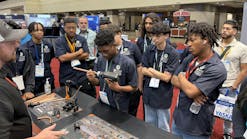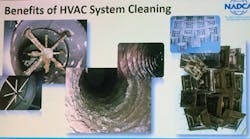Richard Lantz, president & chairman of the board of the National Air Duct Cleaners Association (NADCA), doesn’t mince words when it comes to HVAC systems. Dirty systems are inefficient and don’t operate properly, he says.
In a jam-packed Speaker Session on Monday afternoon at the 2019 AHR Expo ― “HVAC System Cleaning 101,” Lantz told the audience that proper HVAC system cleaning in accordance with ACR, the NADCA Standard, coupled with regular system maintenance will yield optimal system efficiency. He went on to say that research has verified that clean coils result in energy savings. Regular system maintenance results in systems with less fungus, bacteria and mold. And clean systems extend equipment life.
“The age of a building is not an indicator of the dirt level,” notes Lantz. “New buildings can be worse than old buildings.” This seemed to surprise some members of the audience.
When to clean?
NADCA recommends that you clean an HVAC system when it’s:
- contaminated with an accumulation of some type of particulate
- a source of an unacceptable odor
- discharging visible dirt or debris into the conditioned space
- contaminated from fire, smoke and/or water damage
- infested with birds, rodents, insects or their byproducts
- contaminated with construction dust and/or other debris
- mold contamination conditions have reached Condition 2 or 3 (as defined by IICRCS520)
- fiberglass duct liner, duct board or other porous components shows signs of deterioration
An HVAC system should also be cleaned if it’s part of:
- a maintenance program as defined in ANSI/ASHRAE/ACCA Standard 180
- the equipment manufacturer’s recommended maintenance practices
- a proactive energy management program
- a proactive indoor air quality program
- a component to achieve LEED certification
Table 1 in the ACR standard provides some recommended inspection intervals for air handling units, supply duct and return/exhaust duct in various building types (residential, commercial, industrial, healthcare and marine). The recommended intervals are 1 – 2 years.
Cleaning tips
During the Q&A portion of the session, Lantz shared a few interesting tips with the group based on his many years of experience.
When he cleans the coil, he slides a specially-designed metal tray under it to capture all the contaminants. The tray has a built-in drain hole and hose, which directs the contaminated mixture into a bucket. He also recommends cleaning from the bottom up. Cleaning from the bottom up keeps the flow path open below. As you clean the next level up, the contaminant will more easily flow out the bottom. If you clean from the top down, the contaminants will continue to build up below and it becomes nearly impossible to get the bottom of the coil clean.
He also said that ductless units must be cleaned on a regular basis. They get dirty, very quickly. And when he cleans fiberglass duct board he always seals it afterward.
So how do you know when the system is clean? He cited NADCA’s three methods of cleanliness verification: visual inspection, surface comparison test, and NADCA vacuum test.
Key takeaway
Proper HVAC system cleaning can improve a building’s indoor air quality, maintain peak system performance, and provide energy savings.
NADCA's ACR Standard is the international standard for the assessment and restoration of HVAC systems. Visit the NADCA website to download your free copy.









